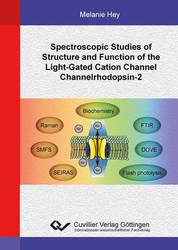| Departments | |
|---|---|
| Book Series (96) |
1377
|
| Nachhaltigkeit |
3
|
| Gesundheitswesen |
1
|
| Humanities |
2362
|
| Natural Sciences |
5405
|
| Mathematics | 229 |
| Informatics | 318 |
| Physics | 980 |
| Chemistry | 1363 |
| Geosciences | 131 |
| Human medicine | 243 |
| Stomatology | 10 |
| Veterinary medicine | 108 |
| Pharmacy | 147 |
| Biology | 835 |
| Biochemistry, molecular biology, gene technology | 121 |
| Biophysics | 25 |
| Domestic and nutritional science | 45 |
| Agricultural science | 1004 |
| Forest science | 201 |
| Horticultural science | 20 |
| Environmental research, ecology and landscape conservation | 148 |
| Engineering |
1789
|
| Common |
97
|
|
Leitlinien Unfallchirurgie
5. Auflage bestellen |
|
Advanced Search
Spectroscopic Studies of Structure and Function of the Light-Gated Cation Channel Channelrhodopsin-2 (English shop)
Melanie Hey (Author)Preview
Extract, PDF (460 KB)
Table of Contents, PDF (38 KB)
Revealing structural and mechanistic details of Channelrhodopsin-2 (ChR2) is in the focus of current scientific research due to its unique ability to stimulate cell activity by light (optogenetics). Hence, ChR2 is a promising tool to revolutionize medical treatment. The aim of this work was the investigation of the light-activated mechanism of the retinylidene cation channel ChR2 on an atomistic level by means of vibrational spectroscopy.
In addition to successful expression and purification of ChR2, resonance Raman and FTIR spectroscopy elucidated the structure of the chromophore binding pocket as well as the gating mechanism triggered by a single hydrogen bond between two residues (“DC gate”). Therefore, FTIR difference spectroscopic results were correlated with time-resolved UV/Vis spectroscopy. Flash photolysis allowed characterization of the time scale of proton release with subsequent uptake using an indicator dye.
Application and modification of advanced biophysical techniques such as surface-enhanced FTIR, single-molecule force spectroscopy and doubly vibrationally-enhanced four wave mixing set the basis to obtain even deeper insights into the structure and function of membrane proteins like ChR2.
| ISBN-13 (Hard Copy) | 9783954046355 |
| Final Book Format | A5 |
| Language | English |
| Page Number | 234 |
| Lamination of Cover | glossy |
| Edition | 1. Aufl. |
| Publication Place | Göttingen |
| Place of Dissertation | Berlin |
| Publication Date | 2014-02-26 |
| General Categorization | Dissertation |
| Departments |
Biochemistry, molecular biology, gene technology
Biophysics |
| Keywords | Channelrhodopsin-2, Spektroskopie, FTIR, Raman, Membranprotein, Optogenetics |








